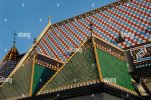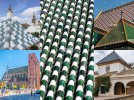Request: More glazed roof tiles
Request Type: Unique Addition (specific to a build, region, or culture)
Describe the use of this block in said build, region, or culture. How is it unique? To the best of your knowledge how could it be used in a different context?

We currently have a couple roof tiles that I would consider glazed: red, blue, green. I think we can add a couple more colours to spice up the special builds of many regions. Personally I can see these being very useful for Dorne and the Vale, both regions that take a lof of inspiration from places in real life that use glazed roof tiles a lot. Having said that, I'm sure they can be used occasionally everywhere. I propose adding 4 new colours as well as a couple blocks that combine 2 colours in a simple pattern.
Types of evidence to support your request: Historical
Historical Evidence
Request Type: Unique Addition (specific to a build, region, or culture)
Describe the use of this block in said build, region, or culture. How is it unique? To the best of your knowledge how could it be used in a different context?

We currently have a couple roof tiles that I would consider glazed: red, blue, green. I think we can add a couple more colours to spice up the special builds of many regions. Personally I can see these being very useful for Dorne and the Vale, both regions that take a lof of inspiration from places in real life that use glazed roof tiles a lot. Having said that, I'm sure they can be used occasionally everywhere. I propose adding 4 new colours as well as a couple blocks that combine 2 colours in a simple pattern.
- Blue-green: We already have a green colour, although it is quite yellow. I would add another green colour that leans more into the blue tones. This glazed roof tile is very common all over, as it can be easily obtained when using certain rusts when baking the tiles. In the Maghreb and muslim Iberia it is used extensibly for the roofs of mosques and other important builds. Dorne would greatly benefit from this addition.

You may have noticed that some of the pictures I've showed have semicircular or hexagonal roof tiles. While they are a cool look, I think I would be best to stick with the texture we've been working with so far, so that all new and old colours can be mixed seemlessly. Also in the case of the blue-green roof tiles the barrel shape is pretty key to the style, so I would stick with it.

Regarding the multicoloured blocks, I would stick with simple combinations of two colours. Ideally I think a diamond pattern is the best route, but if it is found to be a pain to make work as a texture alternating rows can also work and may be enough. There's a million possible combinations, but in order to not clog the menu with all of them I propose these as the ones that we may get the most use out of, as I found them to be common and aesthetically pleasing.

Regarding the multicoloured blocks, I would stick with simple combinations of two colours. Ideally I think a diamond pattern is the best route, but if it is found to be a pain to make work as a texture alternating rows can also work and may be enough. There's a million possible combinations, but in order to not clog the menu with all of them I propose these as the ones that we may get the most use out of, as I found them to be common and aesthetically pleasing.
- Blue-green and white: Very common in Spain and North Africa, could be used occasionally on towers and roofs of improtant buildings in Dorne.
- Blue and white: Very common in Spain too, a little less in North Africa. Same us as the one above.
- Black and white: A basic pattern combination that woulnd't be used alone, but that can work as trim, for example.
- Black and yellow: Very common in central Europe, a great look for the Riverlands and the Vale, and of course the Stormlands as it displays the Baratheon colours.
- Black and red: While I haven't seen this colour combination as much in real life it would be dumb not to add it. Potentially it can be used in Targaryen builds.
- Current green and yellow: Very common in Central Europe too. And the Tyrrell colours.
- Current green and red: Both colours go nice together and it appears in Central Europe frequently.
- Red and yellow: Classic combination and Lannister colours.
- Red and blue: Common combination, bold and contrast-y. Also it displays the Tully colours.
- Red and white: Classic combination, found extensively in Central Europe.
Types of evidence to support your request: Historical
Historical Evidence
Glazed roof tiles are common all over the world for special buildings. In some cultures they are used in religious buildings with their colouring being tied with a deeper meaning. In other cases they display the wealth and symbols of the city that uses them. Many colours are relatively easy to obtain in ceramics, which explains their wide use.








